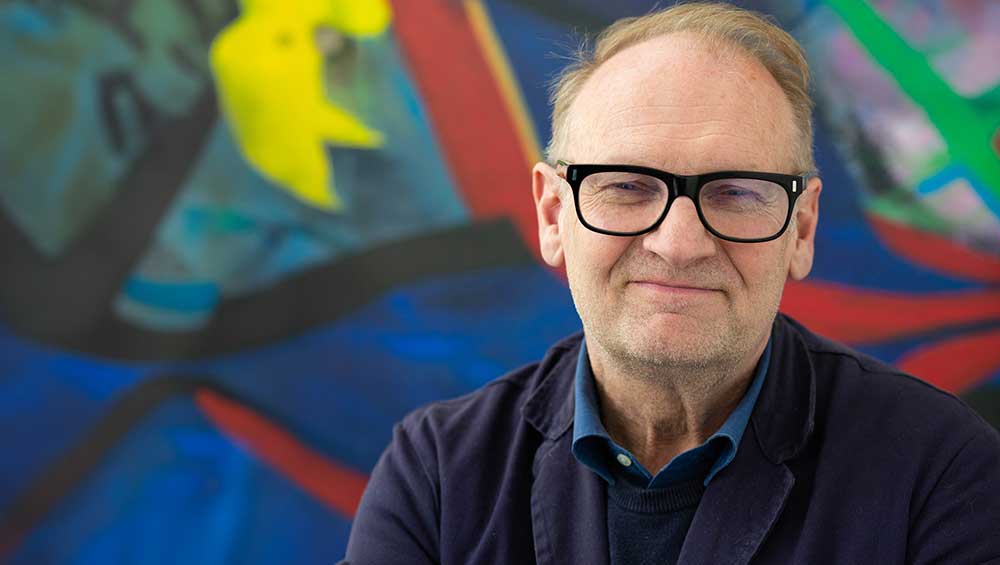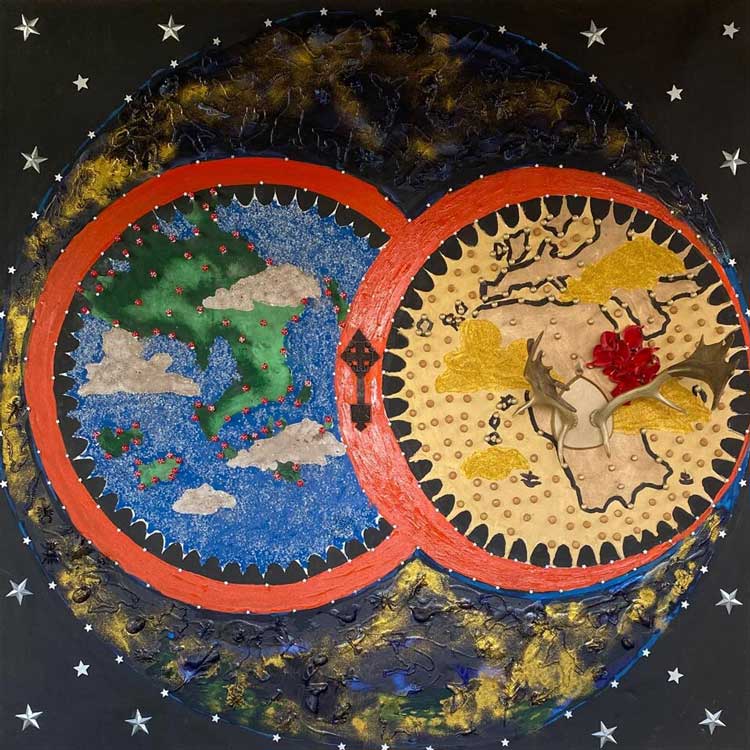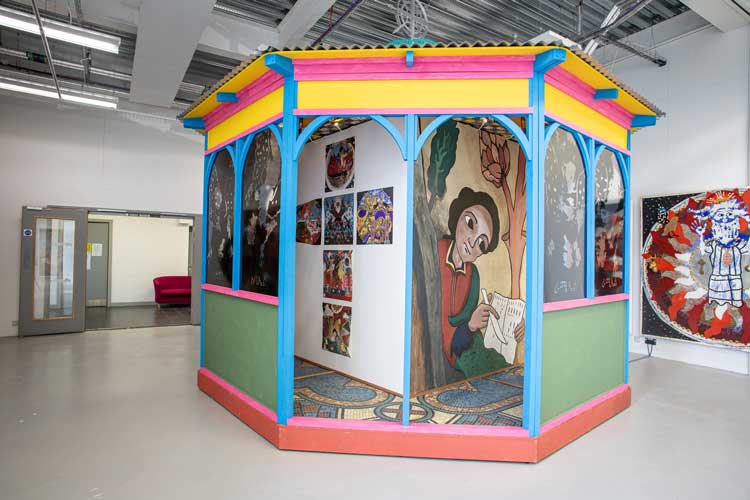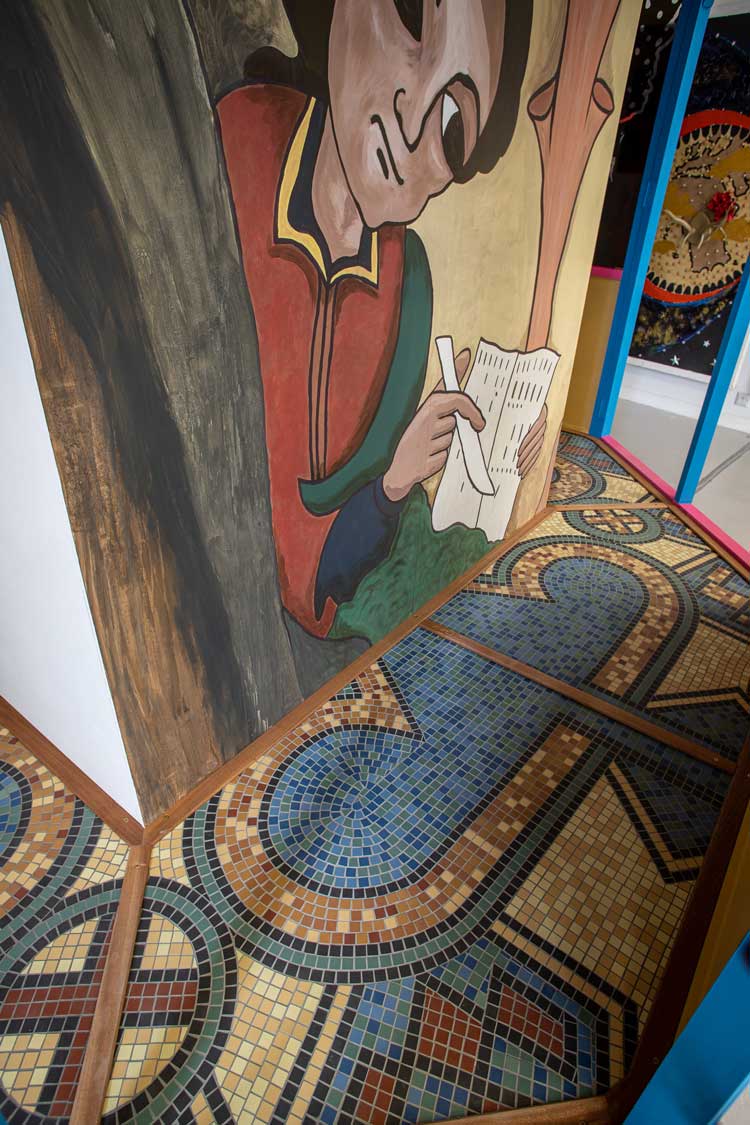
Angus Pryor. Photo courtesy of the artist.
by JANET McKENZIE
The artist Angus Pryor has long been inspired by art and biblical interpretation and he is particularly fascinated by the Book of Enoch. The prophet Enoch was the great-grandfather of Noah. The appeal of the First Book of Enoch lies in the fact that it has been lost to western Christianity for 1,400 years, but is counted in the Ethiopian Orthodox church as scripture. Enoch was one of 19 books removed from the Bible as it was considered by Christians and the church to contradict other books in the Bible. Jewish scholars reject Enoch as being inconsistent with the teachings of the Torah. An Ethiopian version of Enoch was rediscovered in 1773 by the Scottish explorer James Bruce and translated into English by Dr Richard Laurence in 1821.
Apocalyptic in theme, the Book of Enoch addresses the experience of fallen angels (servants of Satan) and the fate of the human soul after death. Professor Philip Esler is the editor of the book The Blessing of Enoch, in which he says: “1 Enoch is significant as a theological text, a text that can speak of human-divine interactions in the present.” Of particular interest, he says, is the work’s “understanding of the nature of evil and the divine response to it”.
In relation to the message in Enoch about environmental disaster, the notion of “the cry of the Earth” is an appeal to stop bloodshed but also to halt the damage to flora and fauna. Esler states: “There is in 1 Enoch a focus on the Earth in its entirety, and this makes good sense within the current discourse of environmental philosophy and theology, with their stress on the interrelatedness of all things.”

Angus Pryor. The Earth Cries Out.
Oil paint, plastic mushrooms, red plastic lilies and deer antler, 200 x 200 cm. Image courtesy the artist.
Esler and Pryor worked together on the exhibition Enoch: Heaven’s Messenger, a product of an important research project involving theologians in the UK, Germany, the US and Ethiopia. Based at the University of Gloucestershire, Cheltenham, the project was conceived in 2015, and funded by the Leverhulme Trust and the British Academy.
For his painting, The Earth Cries Out, Pryor explains: “I started with the idea of Enoch looking down on the Earth, so I looked at Leonardo da Vinci’s drawings of the Earth from a high point, I also remember watching the film Andrei Rublev, directed by Andrei Tarkovsky, that had an above-Earth sequence that began the film.”
Pryor’s fascination with art and biblical interpretation began some years ago. With the curator Lyrica Taylor, assistant professor at Azusa Pacific University in California, he designed the show Still Small Voice: British Biblical Art in a Secular Age (1850-2014) at the Wilson, Cheltenham Art Gallery and Museum, in 2015, and his work was included in Both Ends of Madness (2016) at the APT Gallery in south-east London, which explored the effect of wellbeing on contemporary visual art. He is interested in the impact of 1 Enoch on art and architecture and the re-exploration of modernism in fine art practice. He describes himself as a disruptor choosing the areas that are most open to interpretation and controversy. “I am constantly questioning what is faith and belief and what is not,” he says.
The commission New Directions (2012-2016), for The Grange Tower Bridge hotel, of six large paintings included: The Deluge (2007), Love and Death (2009), The Marriage (2007) and The Canterbury Giant (2008). In God’s Wrath (2015), , exhibited alongside the work in Still Small Voice: British Biblical Art in a Secular Age (1850-2014), he paid homage to Stanley Spencer’s Angels of the Apocalypse (1949). In Woking this summer, Pryor has curated Material Thinking at the Lightbox Gallery, in partnership with the Ingram Collection and the University of Gloucestershire, to bring together a series of like-minded artists who consider the language of material to be the key to making their art.

Angus Pryor. 1 Enoch Church. Installation view, The Hardwick Gallery, 2020. Image courtesy the artist.
Pryor’s contribution to the Enoch project is a series of 21 2 x 2 metre paintings as well as a large-scale model of an Ethiopian church decorated with Ethiopian imagery– an artist’s church. His is a contemporary reading of Enoch that focuses on personal faith, knowledge and the environmental crisis. For the artist’s church, he uses an earth palette in keeping with Ethiopian artistic tradition, and found objects applied directly to the canvas.
Janet McKenzie: Enoch: Heaven’s Messenger is a powerful body of work. How did you discover the ancient text?
Angus Pryor: I was aware of the text through the drawings of William Blake and John Flaxman when I was at Wimbledon College of Art: I was reintroduced to this in Professor Philip Esler’s (Portland Chair of New Testament Studies) Inaugural Lecture for the University of Gloucestershire in March 2014. I was always interested in the fallen angels and their offspring, the Giants. Several ideals held my attention, the teaching of metal work and alchemy and astronomy, the sustainable agenda (the Earth cries out) and the fact that Enoch conversed with God and still walks with him. As a secular artist, I’m always keen on reinterpretation and how this can be created through art. I’m also interested in multilayered text that’s open to interpretation, and I love chaos, so celestial journeys, end-time and wrath and deluge all attract my attention. I’m very interested in being a secular observer so I can give a different interpretation of the text from a non-belief perspective. I like to see the artist role as an independent observer.
JMcK: Enoch is underrepresented in art history. What do you find most appealing as a contemporary artist in the 21st century?
AP: The narrative itself. I could spend the next 20 years completing my response to the full text. I am particularly interested in the animal apocalypse, but that is something for a later project. For its relevance to the 21st centenary, I love the fact that it is discussing where and how the world has evolved as if it’s a being, how mankind evolved from disgruntled angels to be the sentient beings that humans are today. It has so much in common with the Greek myth of Prometheus and the gift of fire. I enjoy joining up the dots and questioning everything, especially oneself.
The text is so rich in ideas, and if you have a belief system, then it really lets you believe; if you don’t, then the reinterpretations can send a very different message. I have discussed before how paintings reveal themselves to the viewer. I am hoping that once the paintings leave the studio, they belong to the new audience for interpretation. I am aware that my paintings can be seen and appreciated by the religious and secular viewer, as I use layers of images to create a painting and this gives many different meanings and interpretations to the individual. I am simply asking a question, rather than giving the answers.

Angus Pryor. 1 Enoch Church (detail). Mixed media with painting installation and mosaic floor, and plastic stained glass ready printed windows, 300 x 200 cm. Installation view, The Hardwick Gallery, 2020. Image courtesy the artist.
JMcK: You were scheduled to show the 21 paintings and the artist’s church in Enoch: Heaven’s Messenger at Gloucester Cathedral and Canterbury Cathedral (2020), but the exhibition in both venues was postponed because of the pandemic, with an online exhibition and catalogue replacing the exhibitions in the short term.
AP: I hope the paintings will be seen in the site-specific context one day. I wanted to see the Ethiopian church within a cathedral to emphasise the grandeur of the small Ethiopian church, to give it its deserved respect in this context. The painting Enoch’s Journeying to the Ends of the Earth has mirrors on its surface, so that you can see the cathedral in the painting, giving the impression that you and the cathedral are beyond the celestial, so that the painting adds a transcendental element to the meaning of Enoch’s education.
JMcK: You consciously sought to transcend merely illustrating the text and have produced a wonderful series of paintings that challenge art historical norms for religious art. Can you describe the process?
AP: First, I am very aware of the context that I’m working in. Looking at the tradition of art historical paintings in cathedrals and churches from Michelangelo to Tiepolo right up to Christopher Le Brun, to Chris Ofili, and then seeing the Ethiopian tradition (having visited Ethiopia) of multilayering the surface of small churches with narratives but seen not as art but essential as a spiritual space.
I wanted to introduce the object as my key to these works (as a post-Duchampian context) so, for example, God’s face in The Tree for the Righteous at the End-Time and God on His Throne were made by printing my son’s face on to the canvas and then painting around this image using printed objects as well as real objects stuck on to the face of the canvas. This starting point was using the image of man to create the image of God, so man is literally in God’s image. As William Blake said: “The imagination is divine.”
I wanted to pick out key elements that illuminated the narrative and develop the first church dedicated to Enoch. This being situated in an Anglican cathedral sends out a powerful message. The relationship of the paintings to the church is key and I also wanted this to be iconic and symbolic of the importance of the Ethiopian tradition and how, through reimaging, the work can be celebratory on many levels.
JMcK: You use found objects, ready-mades in the Duchampian sense, but you also refer to the text as a ready-made. Can you explain?
AP: The book is an object in its own right: everything in the paintings is literally in the text, so I use it as a ready-made so that it’s open to interpretation. To give an example: if a chair is stuck to the wall, is it still a chair (you can’t sit on it); is the text of a book still text if it’s in visual language? It becomes something new and dynamic and multilayered. The language of painting is significant here; I use scale, colour and composition to develop a very specific language about the text. They are not illustration but full of signs and signifiers that express a dynamic about culture and the individual viewer and, most importantly in terms of the audience, this widens the text to a whole new arena of people from different denominations and backgrounds and experience. Many non-literate people and those with dyslexia have experienced the text for the first time from having a visual experience.

Angus Pryor. The Earth Cries Out and God on his Throne. Installation view, The Hardwick Gallery, 2020. Image courtesy the artist.
JMcK: The Book of Enoch is a heady mix – multilayered and dazzling – angels galore, a lot of drama. How difficult was it to home in on aspects, especially within a detailed scholarly project?
AP: As a disruptor, I chose the areas that are most open to interpretation and controversy. I am constantly questioning, what is faith and belief and what is not. I want the audience to read the paintings from a semiotic perspective: the meaning and mode of the images create the tension in the work. The viewer can see the work as pure theology or an alternative perspective on it. I homed in on the series of the text that had the most power for discussion and how it has significantly changed our thinking.
In the painting The Cry of the Earth (1 Enoch 7:6), we view the Earth from the perspective of Enoch as he wanders through the celestial atmosphere. Enoch observes the Earth from within the knowledge limitations of his own era, not yet fully formed and with only a basic understanding of land mass and the oceans, and how they are linked together. But as a heavenly wanderer, he can see the Earth not only spatially but also across time: he is able to survey three separate stages of Earth’s evolution progressing into the future and can therefore foresee how humanity will neglect and slowly destroy the Earth.
JMcK: 1 Enoch recalls an environmental catastrophe that devastates the Earth, animals and people. God sends a flood, but rather than resulting in the end of the world, Enoch assigns the catastrophe to the past: “The entire Earth will be tilled in righteousness, and all of it will be planted with trees, and it will be filled with blessing.” Do you see your role as an artist, like Joseph Beuys, as vital to the future in terms of war and environmental disaster?
AP: Artists are generally the outsiders in society and can observe realities independently. It is our job to put our heads above the parapet and say it as it is. We are the creative thinkers who often have the answers, but can only get this out into society by creating. Like Beuys, I’m keen to create a narrative that has something to add – this may be my interpretation – but I am trying to create a question so that the viewers can come to their own conclusions. These are not illustrations but paintings that use the language of painting to create a dialogue.
What I want to ask is, why do we keep repeating bad lessons? To quote the American writer Joseph Campbell: “It is by going down into the abyss that we recover the treasures of life. Where you stumble, there lies your treasure.” We should have learnt from this ancient text that we can’t go on ignoring all the signs that lead to disaster. If this painting can instigate change, then that is great.

Angus Pryor. Enoch’s Journey to the ends of the earth, 2020. Oil on canvas, deer barometer, glass and plastic mirrors and tine stars. 200 x 200 cm. Image courtesy the artist.
JMcK: Enoch’s Journeying to the Ends of the Earth could be seen as a statement for the power of the visual arts and the importance of art education.
AP: This work is all about the power of imagination. I have imagined the celestial universe that Enoch is taken through, which can now be interpreted and indeed written about from others with an imagination. The painting is exploring Enoch’s education from a visual perspective; this sets him up for how to change the rest of the narrative in the text and, ultimately, he becomes a prophet and walks with God. Without this, he wouldn’t have become God’s scribe.
Enoch is eager to learn and to discover the truth. He is in a place between heaven and Earth, a transformative space that allows him to realise the full magnitude of God’s work and power and to realise, in his honour and awe of God’s creation, that his role is to praise this great work.
The landscape is fantastical with the mountain ranges described in the text like nothing on Earth. Could one of them be God’s seat from where he looks down on humanity and passes judgment? The space is not meant to be either beautiful or abhorrent. It could be both or neither; it is purely fantastic. The ring of silver stars reveals that both our travellers, Enoch and Uriel, are about to pass through the clouds and out into God’s territory, the solar universe. Yet the painting leaves the viewer to wonder and ponder the impossible possibilities of what will happen next.
Can you imagine a world without an arts education in it? All those people who want to use their imagination to change the world. The last Conservative government called art a soft subject, but we are the recorders of history, we are the commentators on the world, we are the disruptors and challengers of the status quo.
• Material Thinking: Discoveries Are Made Through Making, curated by Angus Pryor and including two of his paintings, The Deluge and Judas, is at the Lightbox, Woking, until 13 October 2024. The Blessing of Enoch, edited by Professor Philip Esler, and the exhibition: Enoch: Heaven’s Messenger, by Esler and Pryor, were products of a research project involving theologians in the UK, Germany, the US and Ethiopia. Based at the University of Gloucestershire, Cheltenham, the project was conceived in 2015, and funded by the Leverhulme Trust and the British Academy.